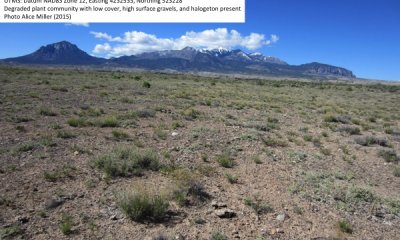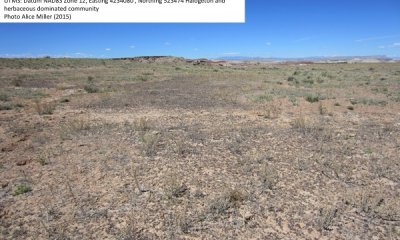
Alkali Fan (Valley Saltbush)
Scenario model
Current ecosystem state
Select a state
Management practices/drivers
Select a transition or restoration pathway
- Transition T1A More details
- Transition T2A More details
- Transition T2B More details
- Transition T3A More details
-
No transition or restoration pathway between the selected states has been described
Target ecosystem state
Select a state
Description
The reference state was determined by literature review, historical accounts and observations of trends in plant community dynamics. Relic areas not influenced by grazing were not located within this site and may not exist. Community composition data were inferred from State 2.
The reference state represents the plant communities and ecological dynamics of this ecological site under pre-settlement conditions and a natural disturbance regime. The plant communities of the reference state were likely similar to the climate induced plant communities of the interpretive state (State 2), and were characterized by a relatively sparse shrub cover of valley saltbush with Indian ricegrass and James’ galleta. Indian ricegrass and valley saltbush cover were likely higher in the reference state (e.g. Baker and Kennedy 1985, Cole et al. 1997). James’ galleta often increases under grazing due to loss of less grazing tolerant species (e.g. Kleiner 1983). Annual forbs were likely sparse and a minor component of the vegetation communities, highly dependent on precipitation timing and amount (Blaisdell and Holmgren 1984). The primary disturbances included fluctuations in precipitation and native ungulate browsing. Plant community composition likely changed during wet and dry periods, fluctuating between community phases 1.1 and 1.2.
Reference State: Plant communities influenced by climate fluctuations between wet and dry periods.
Indicators: Communities dominated by valley saltbush, with Indian ricegrass and James’ galleta important perennial grasses. No invasive species present.
Feedbacks: Natural fluctuations in climate allow for a self-sustaining sparse shrub community with shrub and grass components.
At-risk Community Phase: Community 1.2 is particularly susceptible to damage from livestock grazing, invasion by non-native species, and erosion.
Trigger: Improper livestock grazing in an arid system that did not evolve with large herbivores, which reduced plant cover and disturbed soils, and concomitant invasion of non-native plants that permanently altered ecological dynamics.
Submodel
Description
This state represents the current potential of this ecological site, and the dynamics include disturbance by livestock and invasive species in addition to the climate fluctuations that influenced the reference state. This state will naturally fluctuate between community phases 2.1 and 2.2, and will shift to community phase 2.3 with abusive livestock use. Continued abusive use, especially if coupled with drought, could cause a transition to a degraded state (state 3), or a forb dominated state (state 4).
Current Potential State: Plant communities influenced by climate fluctuations between wet and dry periods, livestock grazing, and invasive plants.
Indicators: Communities dominated by valley saltbush with Indian ricegrass and James’ galleta important perennial grasses. Invasive species including cheatgrass and redstem stork’s bill (Erodium cicutarium) are typically present but not abundant.
Feedbacks: Natural fluctuations in climate allow for a self-sustaining sparse shrub community with shrub and grass components. Improper livestock use that damages soils, reduces vegetative cover and promotes establishment of non-native species.
At-risk Community Phase: Community phases 2.2 and 2.3 are at risk of transitioning to a degraded or forb dominated state with continued abusive livestock grazing use, especially in combination with drought.
Trigger: Continuous improper livestock grazing, or severe drought with invasive plant invasion.
Submodel
Description
This state is characterized by low vegetative cover with eroded soils and dynamics influenced by halogeton invasion. Reduced vegetative cover in this state has exposed soil to erosion, and soil surfaces have high gravel cover, sometimes approaching a desert pavement appearance. Halogeton alters soil biology and chemistry, which can make soils more hostile for native plant recruitment, and facilitates further halogeton establishment. This state is very vulnerable, and continued abusive use, especially if coupled with drought, or severe drought alone could cause a transition to a forb dominated state (State 4).
Degraded State: Plant communities influenced by abusive livestock grazing, climate fluctuations and halogeton invasion.
Indicators: Low vegetative cover and high cover of bare ground and gravels. Halogeton is significant but not dominant. Forbs are more important and diverse in this state than in the interpretive or reference state.
Feedbacks: Improper livestock use that damages soils, reduces vegetative cover and promotes soil erosion, establishment of non-native species, and an increase in forbs.
At-risk Community Phase: Community phase 3.1 is at high risk of transitioning to a forb dominated state (State 4).
Trigger: Continuous improper livestock grazing, and/or severe drought or other disturbance that removes vegetation.
Submodel
Description
This state is characterized by dominance by forbs, with halogeton the most important species. Valley saltbush may be eliminated or greatly reduced. James’ galleta is the dominant grass, and Indian ricegrass may be eliminated or greatly reduced. Desert trumpet (Eriogonum inflatum) may be an important species. Reduced vegetative cover in this state has exposed soil to erosion, and soil surfaces have high gravel cover, sometimes approaching a desert pavement appearance. Halogeton alters soil biology and chemistry, which can make soils more hostile for native plant recruitment, and facilitates further halogeton establishment.
Annual dominated State: Plant communities influenced by climate fluctuations between wet and dry periods, livestock grazing, and invasive plants.
Indicators: Communities dominated by forbs, with halogeton the dominant species. Valley saltbush is eliminated or greatly reduced. High cover of bare ground and gravels, and erosion is typically visible.
Feedbacks: Low or absent cover of native perennials, a halogeton seedbank, and altered soils promote the maintenance of a halogeton dominated state.
Submodel
Mechanism
Transition from reference state (State 1) to interpretive state (State 2). This transition occurred with pervasive intensive livestock use beginning in the 1880’s. Livestock grazing introduced invasive species such as cheatgrass and halogeton, and increased site susceptibility to continued invasion; once established these species are virtually impossible to remove, thus causing a shift to an altered state. The composition and productivity of the altered state was also likely affected, with reduced cover of palatable, grazing intolerant species and increasing the importance of less palatable, more grazing tolerant species.
Mechanism
Transition from interpretive state (State 2) to degraded state (State 3). This transition may occur with continued heavy grazing that reduces valley saltbush cover and exposes soils to invasion by halogeton and erosion.
Mechanism
Transition T2B Transition from interpretive state (State 2) to forb dominated state (State 4). This transition may occur when severe abusive grazing, often in combination with drought, that eliminates or depletes valley saltbush cover to the extent that halogeton and other forbs dominate.
Mechanism
Transition from degraded state (State 3) to forb dominated state (State 4). This transition may occur with continued abusive grazing, often in combination with drought, that eliminates or depletes valley saltbush cover to the extent that halogeton and other forbs dominate. This transition may occur even if livestock grazing is removed if drought or other disturbance removes valley saltbush cover and provides an opening for halogeton to become dominant.
Model keys
Briefcase
Add ecological sites and Major Land Resource Areas to your briefcase by clicking on the briefcase (![]() ) icon wherever it occurs. Drag and drop items to reorder. Cookies are used to store briefcase items between browsing sessions. Because of this, the number of items that can be added to your briefcase is limited, and briefcase items added on one device and browser cannot be accessed from another device or browser. Users who do not wish to place cookies on their devices should not use the briefcase tool. Briefcase cookies serve no other purpose than described here and are deleted whenever browsing history is cleared.
) icon wherever it occurs. Drag and drop items to reorder. Cookies are used to store briefcase items between browsing sessions. Because of this, the number of items that can be added to your briefcase is limited, and briefcase items added on one device and browser cannot be accessed from another device or browser. Users who do not wish to place cookies on their devices should not use the briefcase tool. Briefcase cookies serve no other purpose than described here and are deleted whenever browsing history is cleared.
Ecological sites
Major Land Resource Areas
The Ecosystem Dynamics Interpretive Tool is an information system framework developed by the USDA-ARS Jornada Experimental Range, USDA Natural Resources Conservation Service, and New Mexico State University.







